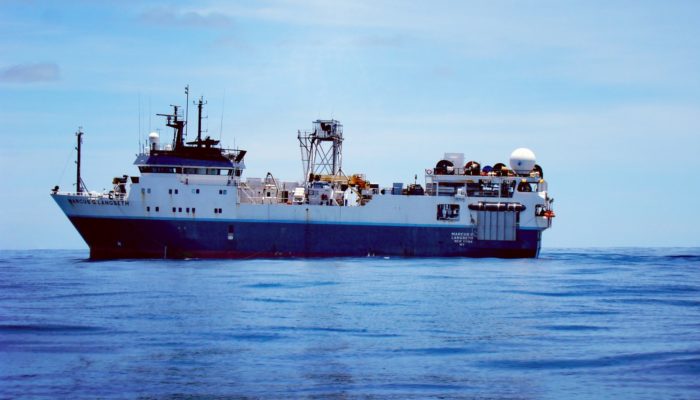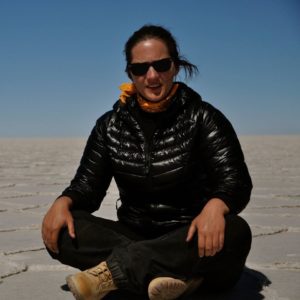
I remember the first lecture vividly, it was on Plate Tectonics. From that moment, I knew what my profession will be
What is your story, Milena?
I am a Marine Geophysicist interested in exploring plate boundaries, in particular, mid-ocean ridges using active source seismology. I am a sea-going researcher, which means that every now and then, I tend to spend several weeks (up to a couple of months) at the open ocean collecting seismic data. I have participated in six research expeditions in the Pacific and the Atlantic Ocean. My latest research adventure took place in the middle of the Atlantic Ocean (Equatorial region), where I am currently trying to solve some of the long-standing mysteries of the deep portions of the oceanic lithosphere.
I knew that I wanted to become geophysicist working on the problems related to Plate Tectonics relatively early on, when I was a high-school student. In Serbia, we have this magic Science Center Petnica that gathers talented and motivated high-school students and offers them an opportunity to make their first steps as researchers in different fields: biology, archaeology, programming, linguistics, math, etc. Of course, I was attending the geology program (in parallel with a regular high school) within which besides geology, I learned how to use scientific literature, how to design and propose a scientific project, make geologic maps, conduct fieldwork, and finally write, and publish papers.
One of the first lectures I received was on Plate Tectonics, which marked me profoundly. I remember that lecture vividly. I was fascinated with the plate reconstruction story and the processes that are taking place at the plate boundaries. From that moment, I knew what my profession will be. This determination led me to obtain an Engineering Degree in Applied Geophysics at the University of Belgrade.
My ambition led me even further. I crossed the ocean to pursue a PhD degree at Columbia University in New York. At Columbia, I was lucky to participate in the very first 3-D active seismic survey to explore the magma plumbing system at the East Pacific Rise, one of the fastest spreading centers on our planet.

Milena aboard R/V Marcus Langseth collecting 3-D active seismic datasets at the East Pacific Rise 9ºN in 2008 (photo credit: M. Xu).
What happened next?
After graduating, I decided to move to France to improve my knowledge on inversion techniques to image and quantify magmatic and hydrothermal processes at mid-ocean ridges. I also designed an ambitious project in collaboration with industry experts for which I was awarded Marie S. Curie Fellowship.
In the future, I would like to remain focused on exploring magmatic systems in deeper portions of the lithosphere. I would like to do a throughout scan of a magmatic system, from its roots at the lithosphere-asthenosphere boundary to the shallow parts of the crust. This work will help us better understand not only magmatic systems at mid-ocean ridges but also extend the lessons learned to volcanic systems on land.
Lately, I have been very interested in the application of artificial intelligence (AI) and machine learning (ML) in Geosciences, which in my opinion will lead to significant breakthroughs. To move forward in this domain, together with my colleagues, I organized a hackathon event, DigitalGeoHack, at IPGP, for which we obtained a grant from European Association of Geoscientists and Engineers (EAGE).
The hackathon was designed to bring together computer scientists, machine learning specialists, and geoscience experts to explore new ideas for digitalization and automation in geophysical research, exploration, and industrial production processes. Two of the conceived projects are in preparation for publications. The summary of the event was published in February issue of First Break Journal.
Promoting women in Geosciences:
In addition to my scientific activity, I am also very active in helping promote women in Geosciences. In 2015, I joined Women in Geoscience and Engineering Group. The mission of the group is to enable the exchange of knowledge and experience, and provide mutual support among members. From 2015-2020, I served as a Committee Member and led several activities:
– A Job Corner Initiative with the objective to share job opportunities in the field of Geosciences in academia, as well as in industry. Until now >2000 job opportunities have been shared throughout the WGE network.
– Organized and led WGE Special Session meetings
– Organized WGE/IPGP workshop on gender equality with the main goal focused on exchange of knowledge and experience between professionals from academia and industry
– Organized e-Mentoring programs for two consecutive years. Also, I have been participating as a mentor of a PhD student from another university in Paris
The results of the work my colleagues and I obtained within the WGE Group were presented at the AGU Fall Meeting 2018 in Washington D.C. within the Education Session focused on Diversity, Inclusion, and Equality in Geosciences.
Women often face sexist micro-aggressions in the workplace, many of which are a result of subconscious biases that people don’t even realize they have. Knowing how to respond to gender bias in the workplace is a touchy subject. Still, it is essential for workers.
Have you ever experienced or witnessed gender bias in the workplace? How did you deal with it? Do you still experience gender bias in spite of your accomplished career?
Unfortunately, I have witnessed and experienced gender bias at work. Three events, in particular, made my determination to dedicate my time and energy to fight against gender bias and inequality in general.
The first event happened when I was in graduate school. It was the moment when one of my female students came to see me during my office hours not to discuss the coursework but to ask me: “Milena, do you think I will ever be able to do science, given that I am a minority and I am a girl?”. It was the moment when I started to ask myself what kind of world are we living in today?!
The second event happened during one of the Open House events in France. After I finished my presentation, experiment and showed a video that depicted the life of a Marine Geophysicist at sea, I held a Q&A session. A girl about 7 years old asked me: “Why do you do all these things, they are so hard for a woman?”. In this kind of situations, it is important to spend time and explain that being a girl does not make them biologically less capable of doing science.
The third event happened during my post-doc. I was introduced to a group of male colleagues, as a Marie S. Curie Fellow. An immediate reaction of one of them was: “It is easy to get Marie Curie these days, you just need to be a woman”. Hell no, it was not easy at all!! Only ~15% of applicants actually do get it. The next day I even came back with the statistics on gender distribution of the fellowship, which showed that in fact, ~60 % of the fellows were men.
We lightly assume that sexism and gender bias come only (or, mostly) from men. Yet, experimental evidence exists that science faculty of both genders exhibit bias against female undergraduates [1].
What are the strategies you try to apply in your everyday life to reduce your own gender bias?
Gender bias is a serious problem in our society. Recent United Nations report has shown that 90% of people all over the world hold some sort of bias against women, which clearly argues for the paradox that women can be and are gender-biased towards other women.
I believe that the best way to avoid the bias of any sort is to first be aware of it. Once you are aware that certain situations make you bias prone, you will learn to think twice about what you say and how you react.
In the past, I attended several workshops that helped me identify some of the situations that can trigger bias in me. When I recognize those situations, I try to question and rethink my potential actions and what impact they may have. Another rule that I invented for myself was not to judge and if my opinion or actions are not constructive then I try to stay out of the situation.
In many ways, society today is turning away from gender bias and sexism more than at any other time in history. Yet gender gaps and inequalities persist.
Why are things not changing faster in your opinion?
We can see that the academic environment is becoming less hostile for female researchers. It is enough to recall that it was in 1959 that women obtained the right to participate in scientific cruises in the United States.
Although now we do not need permissions from a male family member to participate in sea-going expeditions, female researchers from all over the world are still navigating rough seas. There is an evident effort towards closing the gender gap, but it does not seem that our efforts are efficient.
We can take, for example, the rule that has been established recently to include women in scientific panels, committees for grants, and thesis defense juries. In its beginning, the introduction of these rules seemed like a good idea, as they were designed to solve the problem of all-male panels. However, instead of promoting women, the effect of this idea has been resulting in completely the opposite.
First, many women are now dealing with an extra load of work as they are invited to sit at different panels more frequently. This extra load of work leaves them less time to do their research, which then leads to a smaller number of publications, fewer chances to obtain grants…
Second, even if they would do their job flawlessly, they do not gain any respect from their male colleagues as the common comment many of them hear is that they are on the panel just because of their gender.
A very similar effect has been achieved by introducing positive discrimination. We indeed have to begin from somewhere, but it seems that we have not found an effective way to do it.
Research shows [2] that women’s motivation, participation and even perceived interest in STEM is enhanced by having other women in their working groups.
If you were to name a person who inspired you during your career, who would (s)he be? What would you do to help inspire the next generation of female scientists?
There are many people who I admire, who influenced my life and career path. One of them is my PhD advisor, an exceptional Marine Geologist and Geophysicist. In fact, I started admiring my PhD advisor very early on. I was an undergraduate student pursuing an Engineering Degree in Applied Geophysics in Belgrade, dreaming that one day I will do research related to Plate Tectonics.
Besides dreaming, I was reading the book “Plate Tectonics” by Kearey & Vine. While reading, I could not help but notice that a reference Carbotte S. et al., was coming up very frequently. I remember that I was thinking to myself: “This guy rocks!”.
As I did not know many women working in Marine Geophysics, automatically, I thought that the person must be a man. It was during a phone interview as a candidate for a graduate student position at Columbia University that I found out that the letter S next to Carbotte stood for Suzanne!!
The hero of my favorite science book is a woman, and I was about to join her group to work on a 3-D seismic project focused on imaging processes that take place at one of the plate tectonic boundaries!!
Following the example of people I admire, what all of them have in common is honesty and dedication to give their best in everything they do. I would be happy to know if someone at some point could recognize those characteristics in me.
⇒ Go back to the Blog series
____________________________________________________________________________
References:
[1] doi: 10.1073/pnas.1211286109


